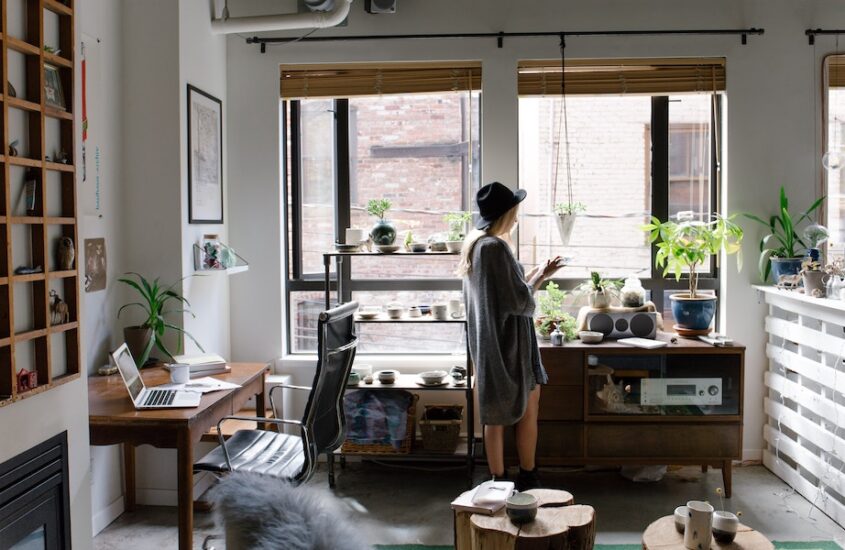Designing the Perfect Home Office for Introverts

Designing the perfect home office can be a transformative experience, especially for introverts who treasure a space that is not only functional but also a sanctuary of solitude and creativity. The significance of a home office goes beyond mere aesthetics; it is about creating a zone that resonates with the introvert’s need for peace, comfort, and minimal distractions.
It’s all about choosing the right elements that contribute to a calm and inspiring atmosphere. From selecting the perfect spot in the home to deciding on the color palette, every detail plays a role in creating a space where an introvert can thrive professionally and personally.
This article aims to guide introverts in creating an office space at home that not only fulfills their work requirements but also helps introverts build a home office that truly feels like their own personal retreat.
An Introvert’s Office Needs
Introverts often prefer environments that minimize external stimulation and provide cozy, comfortable retreats. A well-designed home office for an introvert should be a sanctuary where creativity and concentration flourish without the typical distractions of a busy workplace.
Creating a Minimalist Environment
A minimalist approach helps reduce external stimulation, which is critical for introverts. This involves selecting furniture and decor that are not only functional but also non-distracting.
Opt for clean lines and neutral colors that blend harmoniously, creating a calm and orderly space. Clutter is a significant source of stress and distraction, so keep surfaces clean and items neatly organized.
Comfort and Functionality
Comfort is paramount in a home office. Invest in an ergonomic chair that supports your back and a desk at an appropriate height to prevent strain.
The physical ease provided by such furniture pieces is essential for long hours of work. Additionally, ensure that your office is temperature-controlled. Being too hot or too cold can distract you from your work, so maintaining a comfortable room temperature will help keep your focus intact.
Natural Elements
Incorporating elements of nature can also significantly enhance concentration and reduce stress. Position your desk near a window to benefit from natural light and views of the outdoors.
Natural light is not only good for your eyes but also helps keep your circadian rhythms in sync, improving sleep and overall well-being. If a window isn’t available, good quality artificial lighting that mimics natural light is a suitable substitute.
Personalizing the Space
Though a minimalist setup is recommended, personalizing the space can enhance your connection to it, making it more comfortable and inviting.
This could include art that inspires tranquility, personal mementos that make the space feel yours, or even a small selection of books that you can turn to for a mental break. Each personalized touch should serve a purpose, either functional or motivational, without cluttering the space.
Key Elements of a Home Office
Creating an effective home office involves more than just setting up a desk and a chair; it requires careful consideration of several elements that contribute to both functionality and comfort.
Here’s what you need to focus on to create an optimal workspace:
Quiet Zone
For introverts, the ability to shut out the external world is crucial. Effective soundproofing can enhance concentration significantly. Options like thick carpets and acoustic panels help absorb sound, while noise-canceling headphones can block intermittent noises from outside traffic or household activities. Such modifications create a quieter zone conducive to deep work.
Comfortable Furniture
Physical comfort cannot be overlooked in creating an optimal home office. An ergonomic chair that supports your back and a desk at the correct height prevent physical strain and the distractions that come with discomfort. Look for chairs and desks with adjustable settings to cater to your specific needs, ensuring comfort throughout long working hours.
Lighting
Proper lighting is a critical yet often overlooked component. Natural light is the best choice for enhancing mood and overall productivity; it’s soft on the eyes and can help regulate your circadian rhythms. In settings without natural light, opt for ambient, warm artificial lighting solutions that mimic daylight conditions. Avoid harsh fluorescents that can cause eye strain and mental fatigue.
Planning Your Layout
The configuration of your home office plays a pivotal role in personal efficiency and psychological well-being. Strategic layout planning not only maximizes the use of space but also enhances focus and effectiveness.
Desk Positioning
Position your desk to face towards a window to benefit from natural light, or if that’s not feasible, set up your desk facing away from high-traffic areas to prevent visual distractions. The ideal desk setup provides a clear, uncluttered view, helping you maintain mental clarity.
Functional Zoning
Divide your office area into distinct zones: a primary work area with your computer and essential tools, a reference zone with shelves for books and materials, and a relaxation area where you can step away from work and rejuvenate. This zoning technique helps define physical boundaries within the workspace and aids in mentally segmenting different types of work activities.
Space Utilization
Effective use of space is essential for creating an optimal work environment, especially for introverts who value a structured and distraction-free setting.
Desk Placement
Positioning the desk is more than just an aesthetic decision; it influences productivity and comfort. Ideally, place your desk facing or adjacent to a window. This setup maximizes exposure to natural light, which enhances mood and alertness.
If natural light isn’t an option, arrange your desk to face away from high-traffic areas like the kitchen or living room to minimize visual and auditory distractions. The goal is to face a calm, static scene that promotes focused work sessions.
Zonal Segmentation
Organizing your office space into designated zones helps maintain organization and facilitates efficiency:
- Main Workspace: This is where your computer, essential tech, and immediate work materials are located. Keep this area clean and equipment easily accessible.
- Reference Area: Allocate a space for books, documents, and other reference materials. If space allows, separate this area slightly from the main workspace to reduce clutter around your primary working area.
- Relaxation Corner: Designate a corner with a comfortable chair or small sofa, possibly with a side table and a lamp. This area is for breaks and informal thinking or reading, providing a crucial physical and mental break from work.
Minimizing Clutter
For introverts, a clean environment supports a clear mind. Clutter can lead to cognitive overload, significantly affecting an introvert’s ability to focus and process information efficiently. Implement storage solutions such as:
- Shelves: Use wall-mounted shelves to store and organize books and software which are not in daily use.
- Filing Cabinets: Essential for keeping important documents and files neatly arranged and quickly accessible when needed.
- Desk Organizers: Invest in organizers to manage everyday essentials like pens, notebooks, and stationery. This keeps your primary workspace uncluttered and ready for productive sessions.
Selecting the Right Decor
Decor isn’t just about aesthetics; it significantly impacts your psychological comfort and productivity, especially in a space where you spend considerable hours like your home office.
Choosing Appropriate Colors
The color palette of your office plays a critical role in setting the mood and influencing your stress levels. Opt for soft, muted colors:
- Blues: Known for their calming effects, shades like sky blue or soft azure can help reduce feelings of anxiety.
- Greens: Natural green hues promote relaxation and are easy on the eyes, making them ideal for spaces where you need to concentrate.
- Grays: Light to medium grays serve as excellent neutral backgrounds that can help minimize distractions.
While these colors are soothing, adding a few vibrant accents can energize the space without overwhelming it. Consider a bright vase, picture frames, or decorative items in bold colors to inject personality and life into your office.
Integrating Comforting Textures
Textures add a tactile dimension to your office, enhancing the overall comfort and appeal:
- Plush Rugs: A soft rug not only adds a touch of warmth but also can dampen sound, contributing to a quieter environment.
- Wooden Accents: Elements like a wooden desk, shelves, or picture frames bring a natural, grounding effect to your office. They are aesthetically pleasing and can make the space feel more cohesive.
- Soft Throws and Cushions: These are perfect for the relaxation area of your office. They invite you to take breaks in true comfort, thus refreshing your mind for better productivity.
Technology for Productivity
Integrating the right technology into your home office setup is crucial for maximizing productivity while minimizing distractions, a common need for introverts.
Essential Tech for Introverts
High-Quality Headphones
Ambient noise can be a significant distraction, particularly for introverts who prefer working in quiet environments. Investing in high-quality, noise-canceling headphones can make a substantial difference.
These devices use advanced technology to block out background noise, allowing you to concentrate fully on your tasks. Whether it’s street noise, household commotion, or noisy neighbors, noise-canceling headphones help create a sound-controlled environment conducive to deep work.
Productivity Software
Software tools are invaluable for managing your workload efficiently:
- Task Management Apps: Tools like Asana, Trello, or Microsoft To-Do can help organize tasks and deadlines, making it easier to keep track of ongoing projects and daily tasks. They allow you to visualize workflows and prioritize your work effectively.
- Focus Enhancers: Applications such as Freedom or Cold Turkey block distracting websites during work hours. By limiting interruptions from social media and other websites, you ensure that your focus remains on work, significantly boosting productivity.
- Calendar Apps: Google Calendar or Outlook can be synchronized across all your devices, providing reminders and helping you manage your time. Scheduled alerts for breaks and specific task times can help maintain a steady work rhythm without burnout.
Implementing Tech Solutions
To effectively utilize these technologies, tailor your tech stack to match your specific needs. For example, if external noise is a frequent issue, a combination of noise-canceling headphones and a white noise machine might enhance your concentration.
Similarly, combining task management software with focus-enhancing tools can provide a framework for maintaining productivity and avoiding distractions.
Maintaining Privacy
For introverts, privacy is not just a preference—it is essential for productivity and well-being. A few straightforward enhancements can significantly bolster the privacy of your home office.
Privacy Tips for the Introverted Worker
For introverts, privacy in the workplace is not just a luxury; it’s a necessity for deep focus and high productivity. In a home office, maintaining privacy can be challenging, especially if you share your living space with others.
Door Locks
One of the simplest yet most effective ways to secure your workspace is to install a reliable door lock. This ensures that you can work undisturbed, particularly important in a busy household.
A good lock keeps casual interruptions at bay and signals to others that you are in a zone of serious focus. Consider a lock with a do-not-disturb indicator for added clarity, preserving your peace and quiet.
Window Treatments
Windows can be a source of distraction if not properly managed. Use curtains or blinds to control the amount of natural light entering the office and protect against unwanted eyes.
Opting for adjustable blinds allows you to change the lighting as needed throughout the day, while blackout curtains can eliminate light during video calls or when concentration is crucial. Both options enhance privacy and can also improve energy efficiency by insulating the room.
Taking Seclusion to Another Level
Beyond locks and curtains, consider these additions:
- Privacy Screens: If your office space has glass partitions or you are using a part of a room as your office, a privacy screen can be a practical addition. It’s movable, allowing flexibility in how you set up your space depending on your current privacy needs.
- Soundproofing Elements: Adding bookshelves densely packed with books, wall hangings, or even specialized soundproofing panels can help mute incoming noise from other parts of your home.
Building a Personal Sanctuary
Personalizing your home office is about creating a space that not only serves your functional needs but also reflects your personality and benefits your emotional well-being. This personal touch can significantly increase your comfort and deepen your connection to the workspace.
Personalization Ideas for an Inviting Office
Personalizing your home office not only increases your comfort but also boosts your productivity by making the space uniquely yours.
Here are some creative ideas to help you transform your office into an inviting and inspiring workspace:
Art and Philosophy
Decorating your office with art or photographs that depict serene and tranquil scenes can have a calming effect, making it easier to focus and stay productive.
Choose imagery that inspires or relaxes you, such as landscapes, abstract pieces with soothing colors, or personal photographs that evoke happy memories. The presence of delightful visuals can transform your office into a more personal and enjoyable workspace.
Incorporating Plants
Plants are more than just decorative accents—they enhance the overall quality of your office environment. Benefits of adding greenery include:
- Improved Air Quality: Plants like spider plants, snake plants, and peace lilies can purify the air, reducing the potential for headaches and respiratory issues.
- Increased Calm: Green spaces are known to lower stress and promote relaxation. Even small tabletop plants can add a sense of peace and a splash of life to your office.
- Aesthetics: Plants bring a vibrant, lively element to the decor. They can soften the harsh lines of electronic equipment and furniture, making the space more inviting.
More Ways to Personalize
To further enhance your office into a sanctuary, consider these additions:
- Personal Mementos: Items such as a favorite mug, a gifted desk accessory, or a custom calendar with family photos can make your space feel uniquely yours.
- Comfort Items: Including a plush throw or a cushioned footrest can provide extra comfort that makes long periods of sitting more bearable and pleasant.
- Lighting: Adjustable lighting, like a desk lamp with different color temperature settings, allows you to change the intensity and warmth of your light based on the time of day or the task at hand.
The Perfect Office for an Introvert
Designing the perfect home office is not just about aesthetic appeal but about creating a conducive, comfortable environment that introverts can truly appreciate. By following these guidelines, introverts can create a space that not only meets their professional needs but also improves their mental and emotional well-being. Start creating your ideal retreat and boost your productivity in the comfort of your own home.
Furthermore, by personalizing this space to align with individual preferences, introverts can ensure that their home office is a true reflection of their personality, which in turn enhances their sense of belonging and ownership. It becomes a place where they are most comfortable, ensuring that they can remain focused and effective in their tasks.
Whether it’s through the strategic placement of furniture, choice of technology, or the design elements that reduce distractions, each detail contributes to a more harmonious work environment. Embrace these principles to build a workspace that not only inspires creativity but also supports your
Hana Othman
Latest posts by Hana Othman (see all)
- How To Plan a Retreat as an Introvert - April 26, 2024
- An Introvert’s Guide to Enjoying Group Tours - April 23, 2024
- Designing the Perfect Home Office for Introverts - April 18, 2024






